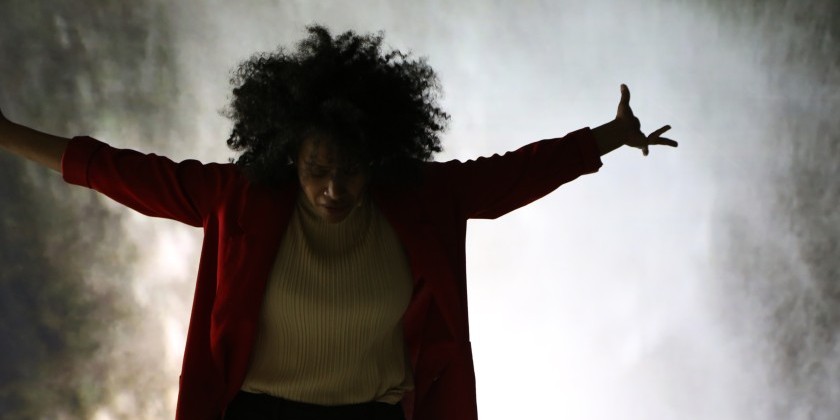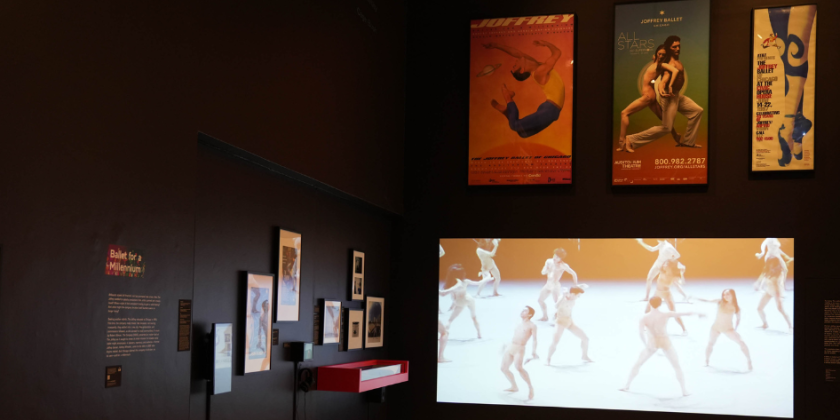IMPRESSIONS: "Distances Smaller Than This Are Not Confirmed" by David Neumann and Marcella Murray, Presented by Abrons Arts Center and The Chocolate Factory

January 15, 2020
Produced by Advanced Beginner Group, and associate produced by Mabou Mines
Co-created by David Neumann and Marcella Murray
Performers: David Neumann, Marcella Murray, Hyung Seok Jeon, Julius Powell
Sound design and lead collaborator: Tei Blow // Video Design: Hyung Seok Jeon
Set and Props Design: Chris Green // Lighting Design: Marika Kent // Original Music: Stew
Costume Design: Montana Blanco // Dramaturg: Melanie George
Cosmic forces are tearing at David Neumann and Marcella Murray, simultaneously pushing them together and pulling them apart. That’s not to mention the powerful emotions that arise when Americans of different backgrounds come together to talk about race. Yet these two performance artists remain poised and dignified throughout Distances Smaller Than This Are Not Confirmed, the multi-media dialog that opened at the Abrons Arts Center on Wednesday.
Though both performers seem uncomfortable, this conversation is important to them and neither is willing to give up trying to connect. A deeper understanding of their subject is essential to all of us, so we can be thankful that, while taking breaks to dance and shake out the tension, Murray and Neumann remain engaged. Though exposed to sharp objects, the delicate threads that tie them together are never severed. For one night, at least, good intentions triumph.

The co-creators of this show, who have been carrying on this dialog in real life, concluded that dramatizing their conversation required a broader context. So Distances presents what appears to be a televised interview between a geeky commentator (Neumann) and a brainy science-fiction writer (Murray), set against a background of billions and billions of stars. In other words, while getting close enough to generate friction, Murray and Neumann simultaneously pull back as far as possible in light years.
Halfway between a TV studio and the Mission Control center in Houston, the set is littered with obscure gizmos, and illuminated with the light of multiple screens. A pair of assistants scamper through this maze of equipment, making adjustments and offering to provide lunch, although the promised burgers never appear. Live-stream images show us close-ups of Murray and Neumann’s faces, or emphasize the space between them as they sit at a large table.
.jpg)
In this setting, the characters discuss scientific phenomena: the forces of gravity and entropy, quantum physics and the suggestion that there may be 10 dimensions. While the possibilities for personal growth may be as vast as the universe itself, human beings are sadly limited creatures whose eyes can detect only a few of the colors that exist in nature; who are only aware of three spatial dimensions plus Time; and whose puny brains grapple hopelessly with the concept of infinity. Evidently these perceptual limitations are also metaphors for our inability to see past the varieties of human pigmentation, making it difficult for us to live at peace with one another in the absurdly small environmental niche that our species occupies. How pathetic is that?
And so we blunder on. A honking noise greets Neumann’s question, when he asks the writer if she hopes to say something “central” about race in her fiction; and Murray jumps up from the table defensively. She says she writes about all kinds of people, and is embarrassed and insulted by the suggestion that because she is black she has something to prove. For his part, Neumann has trouble answering the question, “When did you first realize you were white?”

Neumann appears unsure of himself, confessing to ignorance and resistance in dealing with the privilege that he didn’t earn, but also never sought. Murray seems guarded and suspicious. Risking enough on the streets of Manhattan, she admits her reluctance to making herself vulnerable in this discussion. She has done a lot of sharing in her day, she tells us. Has her generosity ever been repaid?
The two of them trade stories of their families and of childhood adventures exploring forbidden rooms, where they made discoveries that frightened them. Neumann has an annoying habit of talking over Murray. Is it because he’s white? Because he’s male? Or just because he’s David?

Where and how will this discussion end? Murray and Neumann don’t know. Given the context (which includes a funding connection to the SETI Institute), I find myself imagining a scene following UFO Disclosure. In my fantasy, the conversation has become a threesome, with Murray and Neumann huddling together on the same side of the table, embracing their shared humanity at last as they listen to the anecdotes of a talk-show guest who is extra-terrestrial. But, no. Instead they offer us a soothing image: Murray gently stroking the leaves of a plant, mothering a green little creature that does not steal its energy from anyone, but basks innocently in the sunlight. Perhaps we have the most to learn from this being which has the least to say.
Performances run January 16-25 at the Abrons Arts Center, Henry Street Settlement, 466 Grand Street, New York. Visit www.abronsartscenter.org





![IMPRESSIONS: Johann Diedrick Presents “[ the hurricanes in your mouth ]” at Abrons Arts Center](/images/features_small/Johann_Diedrick_hurricanes_Baranova-1085.jpg)






